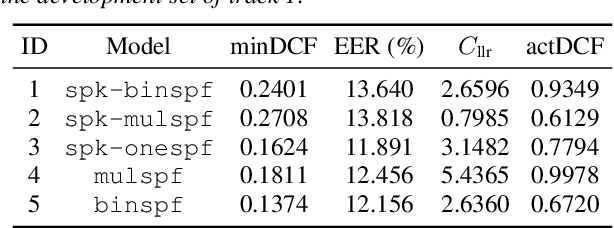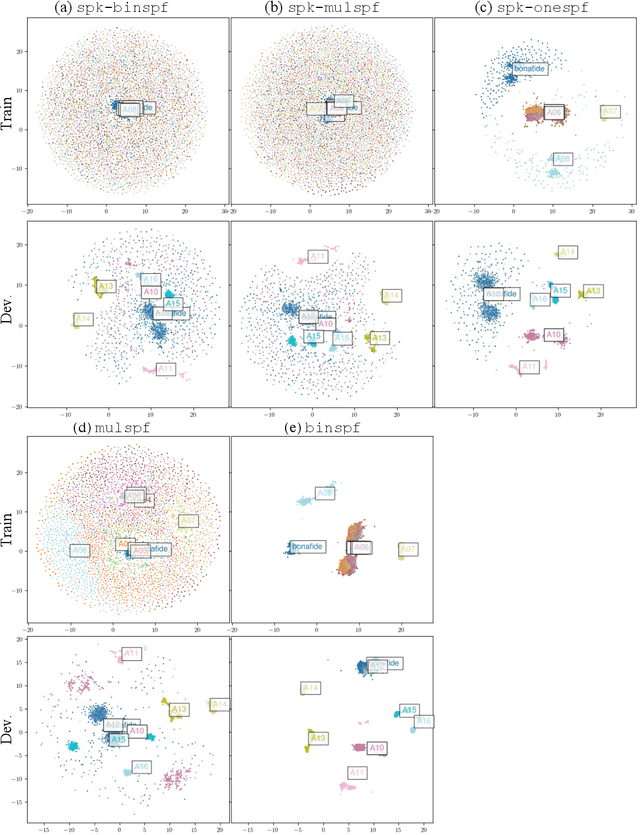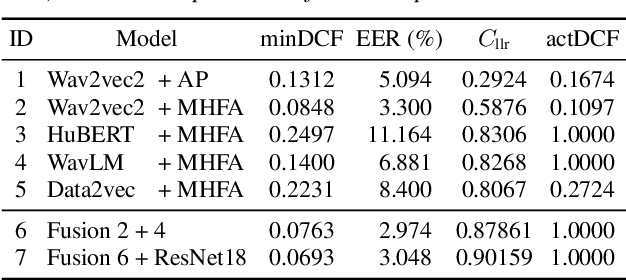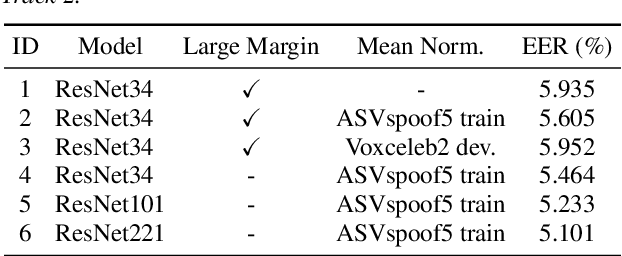Junyi Peng
SoloSpeech: Enhancing Intelligibility and Quality in Target Speech Extraction through a Cascaded Generative Pipeline
May 25, 2025Abstract:Target Speech Extraction (TSE) aims to isolate a target speaker's voice from a mixture of multiple speakers by leveraging speaker-specific cues, typically provided as auxiliary audio (a.k.a. cue audio). Although recent advancements in TSE have primarily employed discriminative models that offer high perceptual quality, these models often introduce unwanted artifacts, reduce naturalness, and are sensitive to discrepancies between training and testing environments. On the other hand, generative models for TSE lag in perceptual quality and intelligibility. To address these challenges, we present SoloSpeech, a novel cascaded generative pipeline that integrates compression, extraction, reconstruction, and correction processes. SoloSpeech features a speaker-embedding-free target extractor that utilizes conditional information from the cue audio's latent space, aligning it with the mixture audio's latent space to prevent mismatches. Evaluated on the widely-used Libri2Mix dataset, SoloSpeech achieves the new state-of-the-art intelligibility and quality in target speech extraction and speech separation tasks while demonstrating exceptional generalization on out-of-domain data and real-world scenarios.
Analysis of ABC Frontend Audio Systems for the NIST-SRE24
May 21, 2025Abstract:We present a comprehensive analysis of the embedding extractors (frontends) developed by the ABC team for the audio track of NIST SRE 2024. We follow the two scenarios imposed by NIST: using only a provided set of telephone recordings for training (fixed) or adding publicly available data (open condition). Under these constraints, we develop the best possible speaker embedding extractors for the pre-dominant conversational telephone speech (CTS) domain. We explored architectures based on ResNet with different pooling mechanisms, recently introduced ReDimNet architecture, as well as a system based on the XLS-R model, which represents the family of large pre-trained self-supervised models. In open condition, we train on VoxBlink2 dataset, containing 110 thousand speakers across multiple languages. We observed a good performance and robustness of VoxBlink-trained models, and our experiments show practical recipes for developing state-of-the-art frontends for speaker recognition.
TS-SUPERB: A Target Speech Processing Benchmark for Speech Self-Supervised Learning Models
May 10, 2025Abstract:Self-supervised learning (SSL) models have significantly advanced speech processing tasks, and several benchmarks have been proposed to validate their effectiveness. However, previous benchmarks have primarily focused on single-speaker scenarios, with less exploration of target-speaker tasks in noisy, multi-talker conditions -- a more challenging yet practical case. In this paper, we introduce the Target-Speaker Speech Processing Universal Performance Benchmark (TS-SUPERB), which includes four widely recognized target-speaker processing tasks that require identifying the target speaker and extracting information from the speech mixture. In our benchmark, the speaker embedding extracted from enrollment speech is used as a clue to condition downstream models. The benchmark result reveals the importance of evaluating SSL models in target speaker scenarios, demonstrating that performance cannot be easily inferred from related single-speaker tasks. Moreover, by using a unified SSL-based target speech encoder, consisting of a speaker encoder and an extractor module, we also investigate joint optimization across TS tasks to leverage mutual information and demonstrate its effectiveness.
SRPO: A Cross-Domain Implementation of Large-Scale Reinforcement Learning on LLM
Apr 22, 2025Abstract:Recent advances of reasoning models, exemplified by OpenAI's o1 and DeepSeek's R1, highlight the significant potential of Reinforcement Learning (RL) to enhance the reasoning capabilities of Large Language Models (LLMs). However, replicating these advancements across diverse domains remains challenging due to limited methodological transparency. In this work, we present two-Staged history-Resampling Policy Optimization (SRPO), which surpasses the performance of DeepSeek-R1-Zero-32B on the AIME24 and LiveCodeBench benchmarks. SRPO achieves this using the same base model as DeepSeek (i.e. Qwen2.5-32B), using only about 1/10 of the training steps required by DeepSeek-R1-Zero-32B, demonstrating superior efficiency. Building upon Group Relative Policy Optimization (GRPO), we introduce two key methodological innovations: (1) a two-stage cross-domain training paradigm designed to balance the development of mathematical reasoning and coding proficiency, and (2) History Resampling (HR), a technique to address ineffective samples. Our comprehensive experiments validate the effectiveness of our approach, offering valuable insights into scaling LLM reasoning capabilities across diverse tasks.
ESPnet-SpeechLM: An Open Speech Language Model Toolkit
Feb 21, 2025



Abstract:We present ESPnet-SpeechLM, an open toolkit designed to democratize the development of speech language models (SpeechLMs) and voice-driven agentic applications. The toolkit standardizes speech processing tasks by framing them as universal sequential modeling problems, encompassing a cohesive workflow of data preprocessing, pre-training, inference, and task evaluation. With ESPnet-SpeechLM, users can easily define task templates and configure key settings, enabling seamless and streamlined SpeechLM development. The toolkit ensures flexibility, efficiency, and scalability by offering highly configurable modules for every stage of the workflow. To illustrate its capabilities, we provide multiple use cases demonstrating how competitive SpeechLMs can be constructed with ESPnet-SpeechLM, including a 1.7B-parameter model pre-trained on both text and speech tasks, across diverse benchmarks. The toolkit and its recipes are fully transparent and reproducible at: https://github.com/espnet/espnet/tree/speechlm.
Investigation of Speaker Representation for Target-Speaker Speech Processing
Oct 15, 2024



Abstract:Target-speaker speech processing (TS) tasks, such as target-speaker automatic speech recognition (TS-ASR), target speech extraction (TSE), and personal voice activity detection (p-VAD), are important for extracting information about a desired speaker's speech even when it is corrupted by interfering speakers. While most studies have focused on training schemes or system architectures for each specific task, the auxiliary network for embedding target-speaker cues has not been investigated comprehensively in a unified cross-task evaluation. Therefore, this paper aims to address a fundamental question: what is the preferred speaker embedding for TS tasks? To this end, for the TS-ASR, TSE, and p-VAD tasks, we compare pre-trained speaker encoders (i.e., self-supervised or speaker recognition models) that compute speaker embeddings from pre-recorded enrollment speech of the target speaker with ideal speaker embeddings derived directly from the target speaker's identity in the form of a one-hot vector. To further understand the properties of ideal speaker embedding, we optimize it using a gradient-based approach to improve performance on the TS task. Our analysis reveals that speaker verification performance is somewhat unrelated to TS task performances, the one-hot vector outperforms enrollment-based ones, and the optimal embedding depends on the input mixture.
State-of-the-art Embeddings with Video-free Segmentation of the Source VoxCeleb Data
Oct 03, 2024



Abstract:In this paper, we refine and validate our method for training speaker embedding extractors using weak annotations. More specifically, we use only the audio stream of the source VoxCeleb videos and the names of the celebrities without knowing the time intervals in which they appear in the recording. We experiment with hyperparameters and embedding extractors based on ResNet and WavLM. We show that the method achieves state-of-the-art results in speaker verification, comparable with training the extractors in a standard supervised way on the VoxCeleb dataset. We also extend it by considering segments belonging to unknown speakers appearing alongside the celebrities, which are typically being discarded. Overall, our approach can be used for directly training state-of-the-art embedding extractors or as an alternative to the VoxCeleb-like pipeline for dataset creation without needing image modality.
BUT Systems and Analyses for the ASVspoof 5 Challenge
Aug 20, 2024



Abstract:This paper describes the BUT submitted systems for the ASVspoof 5 challenge, along with analyses. For the conventional deepfake detection task, we use ResNet18 and self-supervised models for the closed and open conditions, respectively. In addition, we analyze and visualize different combinations of speaker information and spoofing information as label schemes for training. For spoofing-robust automatic speaker verification (SASV), we introduce effective priors and propose using logistic regression to jointly train affine transformations of the countermeasure scores and the automatic speaker verification scores in such a way that the SASV LLR is optimized.
Target Speech Extraction with Pre-trained Self-supervised Learning Models
Feb 17, 2024Abstract:Pre-trained self-supervised learning (SSL) models have achieved remarkable success in various speech tasks. However, their potential in target speech extraction (TSE) has not been fully exploited. TSE aims to extract the speech of a target speaker in a mixture guided by enrollment utterances. We exploit pre-trained SSL models for two purposes within a TSE framework, i.e., to process the input mixture and to derive speaker embeddings from the enrollment. In this paper, we focus on how to effectively use SSL models for TSE. We first introduce a novel TSE downstream task following the SUPERB principles. This simple experiment shows the potential of SSL models for TSE, but extraction performance remains far behind the state-of-the-art. We then extend a powerful TSE architecture by incorporating two SSL-based modules: an Adaptive Input Enhancer (AIE) and a speaker encoder. Specifically, the proposed AIE utilizes intermediate representations from the CNN encoder by adjusting the time resolution of CNN encoder and transformer blocks through progressive upsampling, capturing both fine-grained and hierarchical features. Our method outperforms current TSE systems achieving a SI-SDR improvement of 14.0 dB on LibriMix. Moreover, we can further improve performance by 0.7 dB by fine-tuning the whole model including the SSL model parameters.
Probing Self-supervised Learning Models with Target Speech Extraction
Feb 17, 2024Abstract:Large-scale pre-trained self-supervised learning (SSL) models have shown remarkable advancements in speech-related tasks. However, the utilization of these models in complex multi-talker scenarios, such as extracting a target speaker in a mixture, is yet to be fully evaluated. In this paper, we introduce target speech extraction (TSE) as a novel downstream task to evaluate the feature extraction capabilities of pre-trained SSL models. TSE uniquely requires both speaker identification and speech separation, distinguishing it from other tasks in the Speech processing Universal PERformance Benchmark (SUPERB) evaluation. Specifically, we propose a TSE downstream model composed of two lightweight task-oriented modules based on the same frozen SSL model. One module functions as a speaker encoder to obtain target speaker information from an enrollment speech, while the other estimates the target speaker's mask to extract its speech from the mixture. Experimental results on the Libri2mix datasets reveal the relevance of the TSE downstream task to probe SSL models, as its performance cannot be simply deduced from other related tasks such as speaker verification and separation.
 Add to Chrome
Add to Chrome Add to Firefox
Add to Firefox Add to Edge
Add to Edge